Dawson online programme
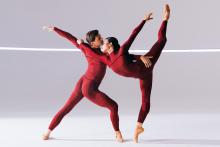
Performance information
Voorstellingsinformatie
Performance information
Legacy Variations
Choreography
David Dawson
Music
Alex Baranowski – Legacy Variations*
Set design
John Otto
Costume design**
Yumiko Takeshima
Lighting design
Bert Dalhuysen
Film
Altin Kaftira
Repetiteur
Raphaël Coumes-Marquet
Assistant to the choreographer
Sandrine Leroy
World premiere at Dutch National Ballet
8 December 2022, Dutch National Opera & Ballet, Amsterdam
Duration
circa 25 minutes
* Music Published by Bright Notion Music Ltd
** Our special thanks goes out to the Merel Laseur Fund, for making the costumes and stage design for Legacy Variations possible.
Legacy Variations is dedicated to Ted Brandsen and Dutch National Ballet, for all the wonderful and creative years shared together. With special thanks to Merel Laseur for her constant support and love.
The Four Seasons
Choreography
David Dawson
Music
Max Richter – The Four Seasons, recomposition of Antonio Vivaldi’s The Four Seasons*
Violin soloist
Isabelle van Keulen
Set design
Eno Henze
Costume design
Yumiko Takeshima
Lighting design
Bert Dalhuysen
Repetiteur
Raphaël Coumes-Marquet
Ballet masters
Charlotte Chapellier
Jozef Varga
World premiere
10 March 2018, Semperoper Ballett, Dresden
Premiere at Dutch National Ballet
15 June 2021, Dutch National Opera & Ballet, Amsterdam
Duration
circa 48 minutes
The Four Seasons is a production of the Semperoper Dresden. As part of the collaboration between the Semperoper Dresden and Dutch National Opera & Ballet, the stage design for The Four Seasons was produced in Dutch National Opera & Ballet’s workshops in Amsterdam.
* Music Published / Licensed by: © Mute Song, Londen / Albersen Verhuur B.V., ’s Gravenhage
Musical accompaniment
Dutch Ballet Orchestra, conducted by Koen Kessels
Sets, props, wigs and makeup, lighting and sound
Technical department of Dutch National Opera & Ballet
Production manager
Anu Viheriäranta
Stage managers
Kees Prince
Wolfgang Tietze
Production supervisor
Puck Rudolph
First carpenter
Jeroen Jaspers
Lighting managers
Angela Leuthold
Michel van Reijn
Lighting supervisor
Wijnand van der Horst
Sound engineer
Eric Nelissen
Video technician
Rutger Flierman
Costume production Legacy Variations
Martine Douma
Costume production The Four Seasons
Kostuumafdeling Het Nationale Ballet in samenwerking met Martine Douma en het Semperoper Ballett
Assistant costume production
Eddie Grundy
First dresser
Andrei Brejs
Introductions (in Dutch)
Jacq. Algra
Total duration
circa one hour and 45 minutes
Dutch Ballet Orchestra
First violin
Hebe Mensinga, concertmaster
Kotaro Ishikawa
Suzanne Huynen
Margot Kolodziej
Majda Varga-Beijer
Catharina Ungvari
Tinta Schmidt von Altenstadt
Bert van den Hoek
Jan Eelco Prins
Mirjam Michel
Robert Cekov
Inge Jongerman
Second violin
Radka Dijkstra-Dohnalová
Lev Adamov
Willy Ebbens
Christiane Belt
Michiel Commandeur
Thirza van Driel
Marina Meerson
Irene Nas
Rossi Ovtcharova
Francesco Vulcano
Viola
Naomi Petersm
Maria Ferschtman
Joël Waterman
Örzse Adam
Giles Francis
Simone van der Giessen
Wouter Huizinga
José Moura Nunes
Ingerid Waleson
Cello
Artur Trajko
Rares Mihailescu
Willemiek Tavenier
Emma Besselaar
Xandra Rotteveel
Renée Timmer
Contrabass
Jean-Paul Everts
Annelies Hemmes
Florian Lansink
Nienke Kosters
Julián Sarmiento
Horn
Christiaan Beumer
Lies Molenaar
Ward Assmann
Milo Maestri
Trumpet
Erwin ter Bogt
Erik Torrenga
Trombone
Bram Peeters
Wilco Kamminga
Harp
Jet Sprenkels
Harpsichord
Jan van Grootheest
General director
Piet van Gennip
Chief conductor
Matthew Rowe
Head of operations and planning
Inken Wemheuer
HR- and office manager
Katharina Schönberg
Music librarian
Nienke de Boer
Assistant music librarian
Ruben Sanderse
Orchestra manager
David Eijlander
Assistant orchestra managers
Diederik Meijnckens
Jack van Heugten
Administrator
Jean Paul du Marchie
Supervisory board
Marianne Heeremans, chair
Fleur Reestman
Michel van Honk
Rutger van Boxtel
Sander Bersee
Cast sheet
The cast sheet for Dawson will be posted on this page one day before the performance and will be available until one day after the performance.
David Dawson about Legacy Variations
After acclaimed ballets such as A Million Kisses to my Skin, The Grey Area, Overture and Citizen Nowhere, David Dawson now presents the world premiere of his 18th work for Dutch National Ballet: Legacy Variations. In choreographing this ballet for three male dancers, he has written a love letter to the company that has been his home for 27 years.
‘A celebration of a shared legacy, beneath the majestic Dutch skies’
You created Legacy Variations as a homage to Dutch National Ballet. What does the company mean to you?
“All my years and experiences with Dutch National Ballet have made me who I am today, and it’s the company that has shaped me – my mind and heart – the most. It’s also the company where I took my first steps towards becoming a choreographer; the place where I learnt about dance and the dance world, how to work and grow, how to persevere, and how to create my own vision. In turn, I’m very proud to be part of the story and development of Dutch National Ballet. Through Legacy Variations, I wanted to create a moment to celebrate our shared legacy, beneath the majestic Dutch skies that connect us all.”
You created Legacy Variations for three male dancers from Dutch National Ballet. Who are these dancers and why did you choose them?
“I’ve made this new work for three very special Dutch National Ballet dancers: James Stout, Edo Wijnen and Joey (Joseph – ed.) Massarelli. I’ve been so lucky to get to know these dancers. I’ve worked with them since the day each of them joined the company, and since then we’ve discovered a way of working together that’s unique. In this new ballet, we reflect on our journey together, on what we’ve learnt and where we’ve arrived.”
What are the specific qualities or characteristics that make these dancers so special?
“James, Edo and Joey are all unique dancers. James is very elegant and stoic, yet sensitive in his dancing. He embodies a purity and can be both strong and vulnerable at the same time. I see him very much as a heroic artist; a poet, a romantic. Edo has the quicksilver qualities of mercury. He shines so brightly and moves in the most profoundly coordinated and musical way. He’s a comet, a star, and he was born to dance. And Joey has an abundant energy that appears endless. His dancing is incredibly organic, earthy in tone, with a deeply felt understanding of his own strength. He radiates kindness and generosity whenever he moves. I hope to be able to show all these qualities within Legacy Variations and to give these extraordinary dancers a platform through which they can surpass themselves.”
For this new piece, you’re working with composer Alex Baranowski, who’s created a brand-new composition for Legacy Variations. How did this process go?
“I got to know Alex during the first months of the COVID-19 pandemic, when I approached him to ask him if he wanted to make a dance film together. We connected immediately and he was wonderful to work with. He has a very distinctive and special musical identity and his music is emotional, universal, vast and intimate at the same time; it’s music that speaks from the heart. After this initial experience, I wanted to create a larger work together. Everything came together very naturally, and Legacy Variations was born. The music tells a story of the heart, of a universal human love, of a certain longing and nostalgia. It tells of the past and the future, of tears and hope. The score Alex has created for Legacy Variations takes you on a journey full of such expansive melodies they make you feel as if you could fly.”
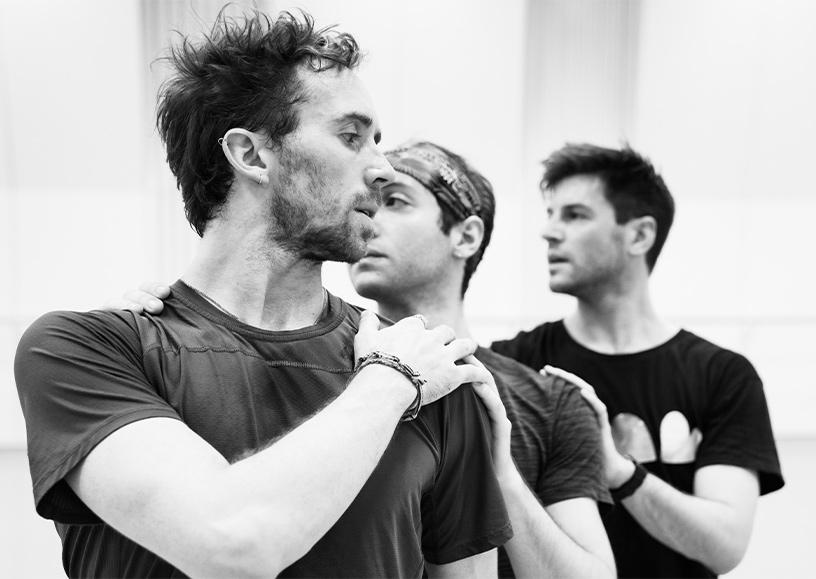
The stage design is in the hands of two designers you’ve worked with many times before: set designer John Otto and costume designer Yumiko Takeshima. What kind of stage design can the audience expect?
“The stage is designed as a world of transparency that unfolds, revealing itself to us piece by piece, moment by moment. John Otto has created a very opaque and romantic space that is stark and open, almost empty. I very much wanted to try to connect this work to the nature of the Netherlands - most importantly the famous Dutch skies. Our trinity of dancers, in dark costumes designed by Yumiko Takeshima, resembles a trinity of sentinels; waiting, and watching over us. In addition, Altin Kaftira has created a film that plays an important role in the performance, acting almost like a fourth character.”
In the programme Dawson, your new work is presented alongside The Four Seasons. How do these two works relate to one another?
“For the most part, Legacy Variations and The Four Seasons are in direct contrast to one another and everything’s in opposition. Whereas one work is about the intimacy of a performance, the other is much bolder. I think my new ballet helps us see and discover the essence of the individual(s), whereas The Four Seasons shows us the power of the many. However, both works are characterised by my dance idiom: how I choose to connect the steps and how they’re presented, and how the movement is approached - both spatially and emotionally.
Legacy Variations was originally intended as a work to be dedicated to Dutch National Ballet, in honour of its 60th anniversary, and to our director Ted Brandsen, who has supported me so much over the years. But now I believe the programme Dawson as a whole celebrates my relationship with the company, and all that we’ve been able to achieve together. It’s a huge honour to be able to create this evening together with everyone at Dutch National Ballet, and to be part of this very special company.”
Artists about their collaboration with David Dawson
During his career as a choreographer, David Dawson has built a diverse team of artists around him. Dancers James Stout, Edo Wijnen and Joseph Massarelli – for whom he created his latest work Legacy Variations – and costume designer Yumiko Takeshima tell about their close collaboration with Dawson.
Artists about their collaboration with David Dawson
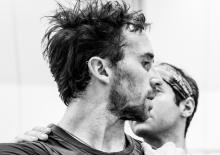
James Stout
“Working with David is more of a collaboration than just him teaching us the choreography. When we start rehearsing, he comes into the studio with some sort of layout or idea, a floor pattern or mood, but he doesn’t have the specific steps yet. He’ll put the music on and start moving, and we try to adjust really quickly and to copy his movements. Of course, this all happens so fast that we can never replicate him exactly, but actually that’s exactly what he wants. He combines our understanding of his movements with the movements he creates himself – making sure every movement is organic. It’s really special that we’re allowed to give our input to a piece, particularly now, when the three of us know David and his work so well. All our ideas and previous experiences come together in Legacy Variations; a piece that really reflects the essence of what we do, what we love and who we are.”
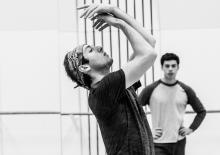
Joseph Massarelli
“Dance isn’t always about tons of pirouettes or the highest jumps. It’s also about the connections you have with your partners on stage. In this new piece, it’s very special for me to be dancing alongside James and Edo, because I was already admiring them in David’s work as a young new dancer to the company. And now we’re dancing together, creating together, and supporting each other throughout the process. The piece really draws on the mutual bonds we’ve built up over the years, and which are still evolving. This creates a lot of energy, which we need too, as David’s ballets are very physical: they have three steps to a beat, compared to others that have just one to a beat. You might think you’d have to make your movements smaller to be faster, but his choreography defies that law: the bigger we make certain movements, the more we can keep going. It has a sort of snowball effect – once you get going, you can’t stop.”
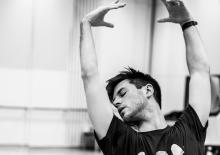
Edo Wijnen
“Our movement idiom clicked from day one. David’s style really appeals to me. The movements I had to ‘unlearn’ for classical ballet are actually encouraged by him. The physical demands they make on you mean you get totally immersed in them. You have to be so focused that you reach a point where you let go of everything outside the choreography and all you can do is abandon yourself to the movement and the moment. What I then show on stage is so pure: at that moment all the audience sees is who I really am. This also happens in David’s new piece, in which we look back on all the great times David, James, Joey (Joseph, ed.) and I have had together in various combinations. The rehearsals for this piece have made me really want to go in to work every day, even though I feel like I’m always at home in David’s style.”
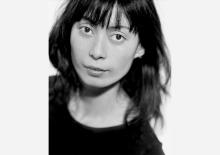
Yumiko Takeshima
“It was actually David who discovered the costume designer in me. In our days with Dutch National Ballet, we often danced together, and when David started choreographing and I was making my own dancewear, he asked whether I’d like to design the costumes for his piece. I wasn’t sure I could do that, but I was so honoured by his question that I had a stab at it. And the rest is history. Because we know each other so well, and because David gives me lots of inspiration through movements and impressions of the atmosphere, I soon get an idea of what he wants. We always keep the costumes simple, however, as dance is all about the dancing and the costumes mustn’t distract from that. The costume designs for Legacy Variations are minimalist as well, but they do have a touch of orange, as the piece is a celebration of ‘Dutch’ National Ballet. I can’t wait to see it all come together – the choreography, dancers, music, scenery, lighting and costumes. It gives me goose pimples every time.”
Interview with set designer John Otto
Set designer John Otto only needed to see one ‘David Dawson’ to decide that he wanted to work with this choreographer. Twenty years later, this collaboration is still just as special, and each creative process brings the two artists even closer together. “It’s a question of teaming up to search, break down and rebuild. My design is an interaction between us.”
‘Embraced, not confined’
His love of opera and ballet was kindled at an early age, and John Otto (New Zealand) still remembers his first performance well. “When Scarpia gets stabbed by the dagger in Act 2 of the opera Tosca, it makes a big impression on a ten-year-old boy!” At home, he liked to create his own performances, in a real puppet theatre. But soon he became more interested in the backdrops than in the puppets themselves. Later, during his set design studies at the Motley School, in London, it was confirmed that this interest was not just a childish whim, but that he did indeed want to make a living out of these ‘backdrops’.
Discovery
Following his studies, Otto got his first official commission from the Nederlandse Opera (now: Dutch National Opera), in Amsterdam – the city where he eventually saw a work by David Dawson for the first time. “I was amazed by the ballet. It was different to the other ballets I’d seen. It was beautiful and had some very interesting aspects. Although it appeared simple, it was very powerful at the same time. I thought these strong dynamics were very special and I asked David if he’d like to work together some time. Then we discovered that we understood each other really well, and that’s still the case today.”
Embraced
For a time, Otto designed sets for both opera and ballet, but nowadays he concentrates on ballet commissions. “Even though they’re probably more difficult. It’s an unusual way of working, because you have to leave as much space as possible for the dancers. They have to stand out, and not be swallowed up by the scenery. You can’t just put something in between them that breaks the tension.” When he’s working with David, he also has to take account of another specific requirement. “David wants the dancers to be embraced, but he wants them to be able to breathe. So I have to play with the space in a different way, so that the sets surround the dancers while not confining them.”
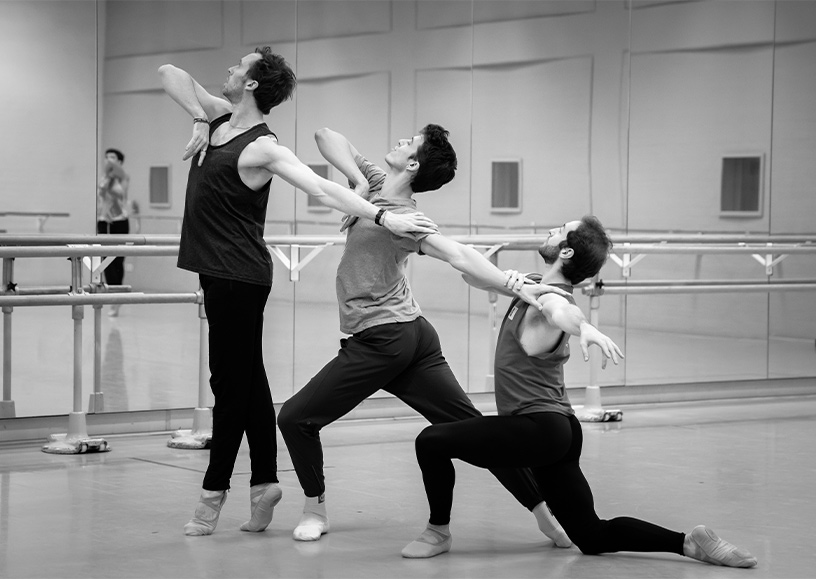
Creative process
In order to create such a design, Otto and Dawson go through different stages together. “Usually, he stimulates my imagination with ideas, following which I build various models. Then we sit down together, pull apart all the components, rebuild them, shift them around and create a new model. I also deliberately put small figures in it, which David moves through the model to look at the dynamics and the distance from the scenery.” And yet… “…we often return to the first idea, which turns out to capture the essence best after all.”
However, all those ideas are not in vain. “Colour or black and white? Very big or actually quite small? A grey wall or a reflective floor? The development of inventive ideas is what makes the creative process so inspiring. The set should be a representation of the atmosphere created on stage – dance needs a sort of background. It’s all about conveying a certain feeling. For this piece, for instance, we eventually switched from colour to grey, and that makes quite a difference.”
Airy sets
“Legacy Variations is an exceptional piece, as David is working with three dancers who are very special to him, and it’s also a celebration of Dutch National Ballet. So we wanted to create something that’s inspired by the Dutch skies – which is now expressed as a sort of open space – but with a familiar, romantic atmosphere. The music has long lines and everything’s really stretched out, so I wanted to reflect that aspect in the sets. In addition, there are three light strips referring to the three dancers, which move up and down and together form the view of the skies. But this projection won’t be too over the top, because it mustn’t steal the show! So the light strips will move very slowly and not bounce up and down.”
Blending together
And finally, everything has to come together. “The choreography, the dancers, the sets, the costumes and the lighting; they all have to form a unity. You should get the feeling that all the elements work well together. On the other hand, it shouldn’t look like a chocolate box. It doesn’t need to be too neat or too sweet. It’s a personal work, with a major role for the relationships between people, but it’s also strong and stormy. Majestic. If that is conveyed – in unison – than something wonderful is created.”
Text: Lune Visser
Interview with Isabelle van Keulen
Just as in the premiere series of David Dawson’s The Four Seasons in 2021, this time the solo part in Max Richter’s music of the same name will once again be performed by renowned violinist Isabelle van Keulen. After playing Vivaldi’s original composition and the totally different versions by Astor Piazzolla and Philip Glass, Richter’s recomposition of Vivaldi’s score is Van Keulen’s fourth ‘four seasons’ composition. And however much she likes the other pieces, she thinks this one is probably the most exciting. “Richter is continually misleading you. Just when you get nicely into it, he changes tack again completely.”
‘Like pulling a square into a diamond shape’
She was nineteen when she first played Antonio Vivaldi’s The Four Seasons, at an open-air concert on Dam Square, in Amsterdam, with the Combattimento Consort, conducted by Jan Willem de Vriend. “I’m afraid it wasn’t my finest performance”, says Isabelle van Keulen. “We were plagued by mosquitos, there was a lot of noise from the spectators and from the trams, and scores were continually blowing away. But for me, it was a concert to remember. I’d just started my studies with Sandor Vegh at the Mozarteum in Salzburg. Up to then, I’d been used to playing all my concert pieces for my teacher – ten, fifty or a hundred times. It was always checked and coached down to the last detail. But when I asked Vegh to work with me on The Four Seasons, he said immediately, ‘Are you crazy? You don’t need to play that piece in my lessons. I’m sure you can rehearse that for yourself.’ For me, that was a real eye-opener. It felt so fantastic that someone said I could do it myself and had such confidence in me.”
Musical innovator
Nowadays, Vivaldi’s The Four Seasons doesn’t cross her path so often any more – “after all, I’m not a Baroque specialist” – but that doesn’t detract from her admiration for the composition. Today, the popular, widely known piece is often maligned and labelled as ‘muzak for the middle classes’; something she thinks is totally unjustified. “Of course you have to look at the times in which it was written. All things considered you could even say it was the first film music ever. Everything is so expressively composed and given such specific references: from the cuckoo you hear and the snores of the drunken men to the cracking of the ice. There’s an idea behind everything. In that respect, Vivaldi was a real innovator, and for that reason he deserves nothing but the greatest respect for his The Four Seasons.”
A whole different world
If she gets the chance, she still thinks it’s ‘terrific’ to play Vivaldi’s original version, but is even happier to play the other three ‘four seasons’ compositions that are now on her repertoire. “It started with Piazzolla’s Las cuatro estaciones porteñas. Like the ‘four seasons’ by Glass, this piece has nothing to do with Vivaldi or cracking ice. You hear four tangos inspired by the seasons in Buenos Aires. Piazzolla is a whole different world for me, in any case; a world that goes very deep and in which you can put all your emotion, unlike the field of classical music. I love the raw character of his music and the enormous freedom he gives you as a musician. Freedom is anyway something I’m always in search of, and what could be better that a composer who’s in fact saying, ‘Improvise your heart out’?”
In Philip Glass’ The American Four Seasons, she says that the whole idea of musical expression of the four seasons is far removed. “It’s just four beautiful paintings, in Glass’ very personal, minimal idiom. But it’s probably the most difficult of the four versions of ‘four seasons’. Technically speaking, it’s an incredibly hard piece and everything has to be absolutely perfect. If the least little thing goes wrong, sounds off key or scrapes, then it really detracts from this piece, whereas it doesn’t hurt Piazzolla at all, or Vivaldi either for that matter. Moreover, Glass’ four seasons flow into one another without the slightest pause for breath. The piece lasts over forty minutes and you have to maintain the suspense throughout.”
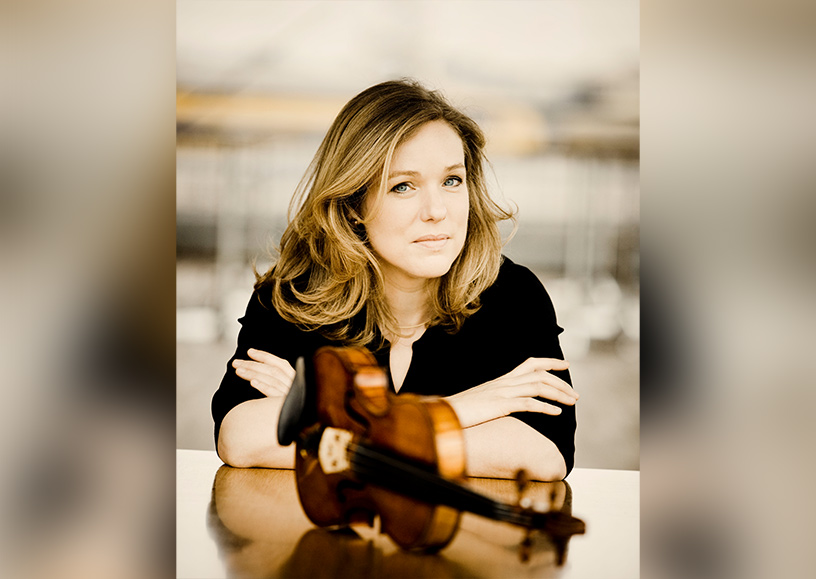
Daring and brazen
The nice thing about Max Richter’s The Four Seasons, says Van Keulen, is that it combines the qualities of the other three compositions, as it were. “Whereas Glass’ seasons form a rounded whole, Vivaldi’s original is a bit ‘hairier’ and Piazzolla’s version, as I said, has a certain roughness, almost coarseness. And Richter manages to bring all these elements together in a fantastic mix.”
It was Dutch National Ballet that invited her, at the end of 2019, to play Richter’s recomposition for the first time in the spring of 2020, for the premiere series of David Dawson’s ballet of the same name (which had to be postponed twice due to the corona restrictions). “I’d heard the music once before, and it gave me a real wow feeling. So when the invitation came, I immediately thought, ‘Yes, I definitely want to do that. That’s right up my street’.”
She calls Richter’s composition ‘quite daring and pretty brazen’. “There’s no copyright on Vivaldi’s music any more, but if there had been I think this might have been a dubious case. Someone could easily have accused him of plagiarism. But personally, I think that’s nonsense. I think it’s wonderful what Richter has done. He’s used existing material and given his own personal take on it in an extremely smart way. It’s Vivaldi with a twist. As a musician and as a listener, you’re continually misled. Some parts are identical to Vivaldi, but the difference in tempo means they’re completely transformed. It’s as if you’re pulling a square into a diamond shape. Vivaldi often remains recognisable, but just when you get nicely into it, Richter changes tack again completely, or you suddenly have one beat more or one beat less. And that’s precisely what makes this piece such fun. It’s continually hop step, hop step. Richter keeps on surprising you.”
Extremely slow
She has since performed Richter’s composition in a concertante version as well, with her own chamber orchestra in Neuss, in Germany. “It was once even in a programme alongside The American Four Seasons by Glass. That was fantastic and exciting, because the two pieces are poles apart, as it were. Whereas you can really have fun listening to Richter, you need full attention and concentration for listening to Glass.”
There’s a big difference between a concert and a ballet performance, she says. “For a ballet performance, of course, I have to adapt to the choreography. Although that’s often restricted to playing just that bit faster or slower, there’s a section of Richter’s composition – in the winter movement – where I have to play extremely slowly, because I have to wait for all the pirouettes and other impressive things the dancers are doing. We rehearsed that at length in the studio prior to the previous series of performances, so that – unlike during the real performance, where I have my head turned to the auditorium – I could see exactly what they needed that time for. When I watch dance, the thing I find strange as a musician is that not everything the dancers do is necessarily on the beat. They do a jump and the note I play has to come just as they’re hanging in mid-air, for example, or just as they land on a shoulder. That’s something I’ve had to learn, in consultation with the dancers, the conductor and – in the case of The Four Seasons – also with the choreographer David Dawson. But this time, Dawson’s ballet will probably be performed by a new cast of dancers, in part, so that requires new rehearsals as well. And I feel a huge responsibility, because those boys and girls of Dutch National Ballet are doing top-class sport, whereas I” – she says laconically – “just have to play.”
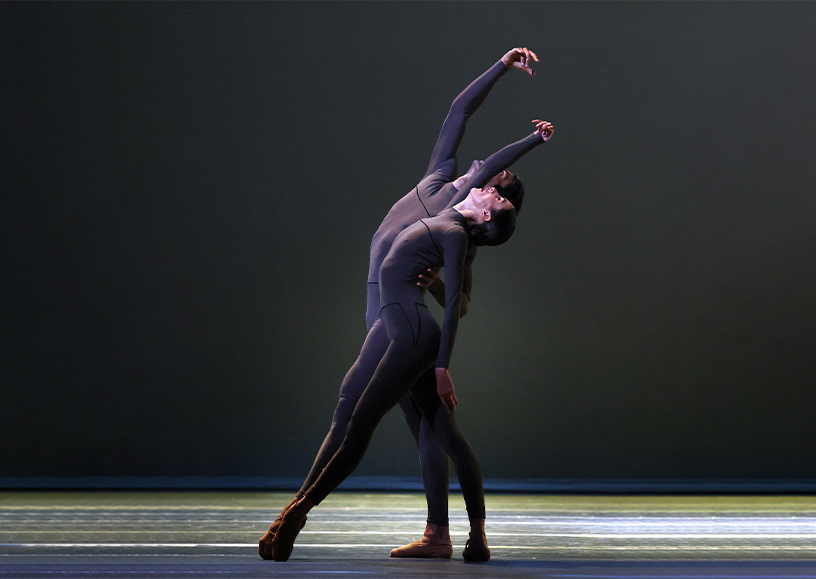
Great luxury
She says that appearing with Dutch National Ballet and the Dutch Ballet Orchestra gives her the opportunity to perform particular compositions for an audience very often in quick succession. “That’s a great luxury for me. It means you really get a piece into your fingers.”
Van Keulen – who lives alternately just outside London, in Hannover and in Lucerne – is looking forward to spending a few weeks in Amsterdam again. The Dutch Ballet Orchestra is now ‘familiar territory’ to her. “I know many of the musicians, some still from my student days. The orchestra also worked for two seasons on the television series Maestro (for which Van Keulen is a jury member – ed.), and I worked previously with the orchestra on Igor Stravinsky’s Violin Concerto, accompanying George Balanchine’s ballet of the same name, for two performance series by Dutch National Ballet. During the second series, my mother passed away, which strengthened the bond between me and the orchestra even further. That bond is very precious to me.”
So, she says, it’s extra nice that this time she can share a more cheerful experience with the orchestra. “On the last performance day of Dawson, I’m celebrating my birthday. It’s wonderful to spend a day like that as part of a team again.”
Text: Astrid van Leeuwen
Programmaboek
Become a Friend of Dutch National Opera & Ballet
As a Friend you support the dancers and makers of Dutch National Ballet. You are indispensable to them and we are happy to do something in return. For Ballet Friends we organize exclusive activities behind the scenes. You will receive the Friends magazine from us, will receive priority when selling tickets and a 10% discount in the National Opera & Ballet shop.
